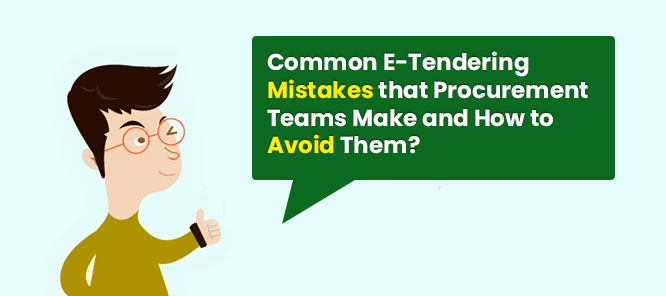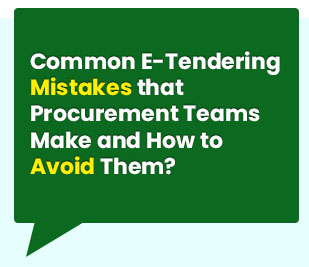Common E-Tendering Mistakes that Procurement Teams Make and How to Avoid Them?


In today’s competitive market, e-tendering is a powerful solution for procurement teams aiming to streamline vendor selection, ensure transparency, and secure the best value for their organizations. But while e-tendering brings efficiency, it also comes with challenges that can derail even the most well-planned bids. Many procurement professionals encounter common mistakes in the e-tendering process that could cost time, money, and credibility if not handled carefully. Here are some practical tips to help procurement teams steer clear of these typical e-tendering mistakes and create successful, effective tendering procedures.
Lack of Clarity in the Requirements and Specifications
Uncertainty or insufficient requirements are among the most common problems in e-tendering. Suppliers find it difficult to match their solutions with the buyer's requirements when specifications are unclear, which can result in poor submissions or non-compliance. Experts advise, "To determine what the organisation needs, start by involving relevant stakeholders early in the process." Create thorough specifications that address every facet of the good or service, ensuring the needs are clear and quantifiable. Before publication, carry out a comprehensive review, and to guarantee uniformity, utilize a standardized template.
Poor Market Research
Sometimes, procurement teams jump right into tendering without fully comprehending the supplier market. This may lead to a small number of responses, exorbitant costs, or the selection of suppliers who are unable to satisfy the needs of the company. We should carry out a thorough market analysis to comprehend the existing situation, available suppliers, and the going rates to avoid the problem. Procurement teams can target the correct suppliers, set reasonable expectations, and steer clear of bids that exceed financial limits according to this research. Requests for information (RFIs) or pre-market engagement events can also be used to gauge the skills and interests of suppliers.
Complex or Lengthy Tender Documents
Complicated and lengthy tender documents can discourage suppliers, particularly small and medium-sized businesses, from entering. Additionally, a document that is too complicated may cause misconceptions regarding the project's deliverables or scope. Try to make your tender paperwork as clear and simple as possible to avoid this. Organise parts clearly, speak simply, and stay away from superfluous legalese. Give suppliers a brief rundown of the project scope, schedule, and evaluation criteria by condensing the document to just the most important details.
Inefficient Communication with Bidders
During the tender process, a lack of consistent, transparent communication with prospective bidders may result in misunderstandings, missing updates, or unresolved queries. This communication gap frequently leads to bids that don't meet requirements or submissions that are delayed. A systematic communication strategy, like a special email address or web page, where bidders may ask questions and get prompt answers, should be established in order to prevent it. Important details can be clarified and constructive bidder involvement encouraged by holding a virtual briefing session. Share any updates or addenda with all prospective bidders in a proactive manner.
Unclear Evaluation Criteria
Procurement teams occasionally neglect to specify the precise criteria by which bids will be assessed. Evaluators may find it difficult to fairly evaluate bids when criteria are ambiguous or subjective, and suppliers may find it difficult to customize their offers. In order to resolve this, Before the start of the tender process, clearly define the weighted criteria and make sure they match the project priorities. These criteria should be made explicit in the tender document, and providers should be provided with instructions on how each area will be assessed. This openness makes it easier for providers to rank their answers and enables assessors to compare them objectively.
Not Doing Enough Research on Selected Vendors
Entering into a contract too quickly without carrying out adequate due diligence can be risky, particularly if the selected supplier is not able or financially stable to complete the deal. To resolve this, do background checks on the vendors you have shortlisted before signing any contracts to address this. This should entail examining their financial stability, industry standing, prior client references, and track record on related projects. By investing time in due diligence, the organization can lower risk and guard against possible problems.
Neglecting Regulatory Standard Compliance
Another frequent problem, particularly with overseas procurements, is noncompliance with legal and regulatory requirements. Penalties, project delays, and reputational harm may result from noncompliance. To prevent it, identify any local, national, or international legal requirements that are pertinent to the project and prioritise compliance from the beginning. Work with your legal team to make sure contracts and tender documents adhere to these guidelines, and stay informed about any changes to industry legislation that may have an effect on the procedure.
Bottom Line
For procurement teams, e-tendering can be an effective tool, but it may not be able to realise its full potential due to common flaws. Organizations can achieve more successful, transparent, and efficient tendering procedures by proactively correcting these errors. Clear communication, strategic planning, and a dedication to ongoing development are crucial. Effective e-tendering not only saves time and money, but it also improves the organization's capacity to find dependable, superior suppliers for long-term alliances.
